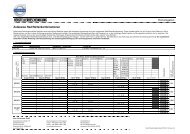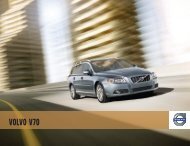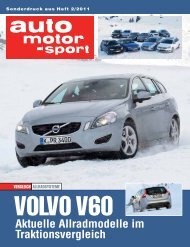performance - Volvo
performance - Volvo
performance - Volvo
Create successful ePaper yourself
Turn your PDF publications into a flip-book with our unique Google optimized e-Paper software.
SAFETY Protective<br />
SAFETY<br />
At the core of every car we make, state-of-the-art technology helps support the driver and<br />
protect the occupants. And to further enhance the <strong>Volvo</strong> safety experience, there’s a range<br />
of supplementary safety technology – for more <strong>performance</strong> and peace of mind.<br />
Passenger airbag cut-off switch<br />
This switch allows you to disengage the passenger<br />
airbag using the car key. When the airbag is<br />
switched off, you are notified via a message on the<br />
roof console display. The force of the passenger<br />
airbag is designed to help protect adults – children<br />
risk serious injury. Therefore, the airbag must first<br />
be disengaged if you intend to put a person shorter<br />
than 140 cm in the front passenger seat.<br />
Whiplash Protection System (WHIPS)<br />
Integrated in the front seats, <strong>Volvo</strong>’s WHIPS<br />
cradles the occupant to help reduce the risk of<br />
whiplash injury (one of the most common types<br />
of traffic injury and often the result of a low-speed<br />
rear impact collision). The function is activated<br />
by a collision of sufficient force from behind.<br />
Independent research has shown that WHIPS is<br />
one of the most effective systems in the world<br />
and can reduce the risk of long-term invalidity<br />
by 50%.<br />
SAFETY Preventive<br />
Dynamic Stability and Traction Control<br />
(DSTC)<br />
By helping to prevent fishtails, spinouts and<br />
rollovers, stability-control technology like DSTC<br />
has been described as one of the most vital<br />
safety advances of the past decade. At the core<br />
of DSTC, a gyroscope senses the car’s direction<br />
and compares this with steering wheel movements<br />
as well as the actual rotation of the car’s wheels.<br />
DSTC is able to detect a potential skid and help<br />
counteract this by reducing the engine’s power<br />
output, or braking on one or more wheels.<br />
Active Bending Lights (ABL)<br />
In addition to improving illumination by about<br />
230% using Dual Xenon light technology, the<br />
Active Bending Lights give a 90% boost to<br />
your vision round bends at night. Controlled by<br />
microprocessors, the motorised lamps turn up<br />
to 15 degrees in either direction when driving<br />
– reliably lighting up your chosen path. A twilight<br />
sensor disengages the adaptive function during<br />
daylight to extend its life span.<br />
Frontal structure<br />
The generous front deformation zones are designed to yield in a controlled way to help absorb crash energy<br />
before it reaches the cabin. The transversely mounted and very compact engine enables optimal use of the<br />
deformation zones to help protect occupants. Longitudinal steel struts help disperse crash energy away<br />
from the front to the rear of the vehicle, further reducing the strain on the occupants.<br />
Restraint technologies<br />
In a collision, <strong>Volvo</strong>’s restraint technologies interact to help reduce the impact. The safety belts with<br />
pre-tensioners activate within a few thousandths of a second in the event of a collision or rollover and<br />
tighten the belt to help keep the occupants securely restrained. The front seat safety belts then release<br />
a little so that the driver and passenger are cushioned by the airbags in a controlled manner. Helping to<br />
optimise protection, the dual-stage airbags adapt the level of inflation depending on the force of the<br />
collision. The driver’s airbag also interacts with the deformation of the collapsible steering column. Side<br />
airbags in the front seats help reduce the risk of serious injuries in a side collision. In a collision or rollover,<br />
the Inflatable Curtain (IC) helps protect the heads of both front and rear outboard occupants. It also<br />
stays inflated for some seconds to provide prolonged protection for subsequent impacts.<br />
Water-repellent front side windows<br />
To help offer far better visibility in the rain, these front side windows help repel water as you drive.<br />
The hydrophobic surface treatment turns water into small drops that are blown away by the force of the<br />
wind. This also gives you the benefit of less ice or frost in winter conditions.<br />
Roll Stability Control (RSC)<br />
In the event of an emergency manoeuvre, <strong>Volvo</strong>’s Roll Stability Control (RSC) can step in to help prevent<br />
the vehicle from rolling over. It features a gyroscopic sensor that registers the vehicle’s lean angle and<br />
rollover risk. If required, RSC will cut engine power or brake one or more of the wheels just enough to<br />
reduce the centrifugal force and help regain balance.<br />
Lower cross member<br />
To help protect the occupants in an oncoming<br />
car with lower positioned bumpers, there’s a low<br />
cross member integrated in the front structure.<br />
In an impact, this cross member is designed to<br />
help activate the other car’s own crumple zones<br />
and other safety systems to help reduce the risk<br />
of injury.<br />
52 53

















